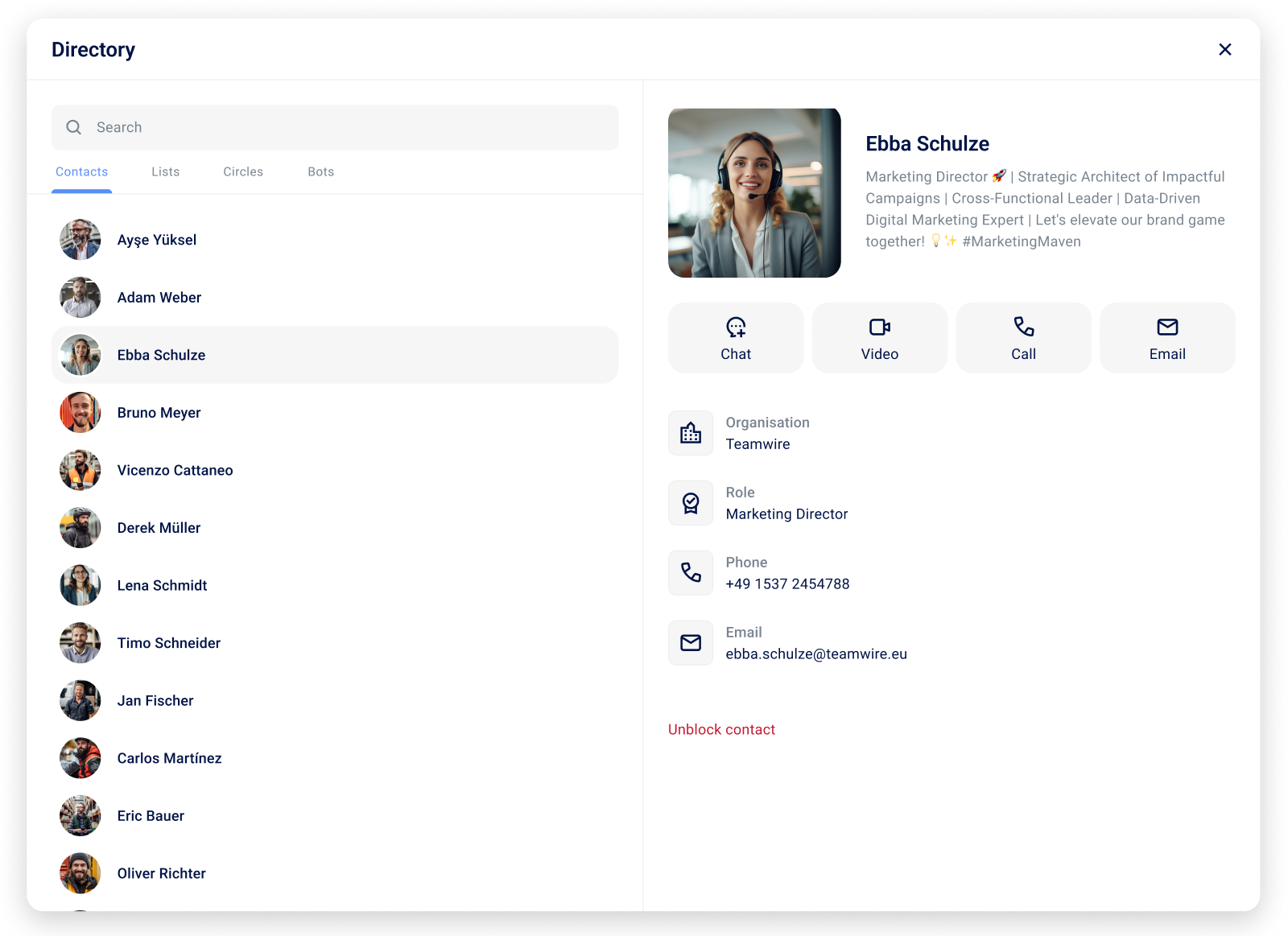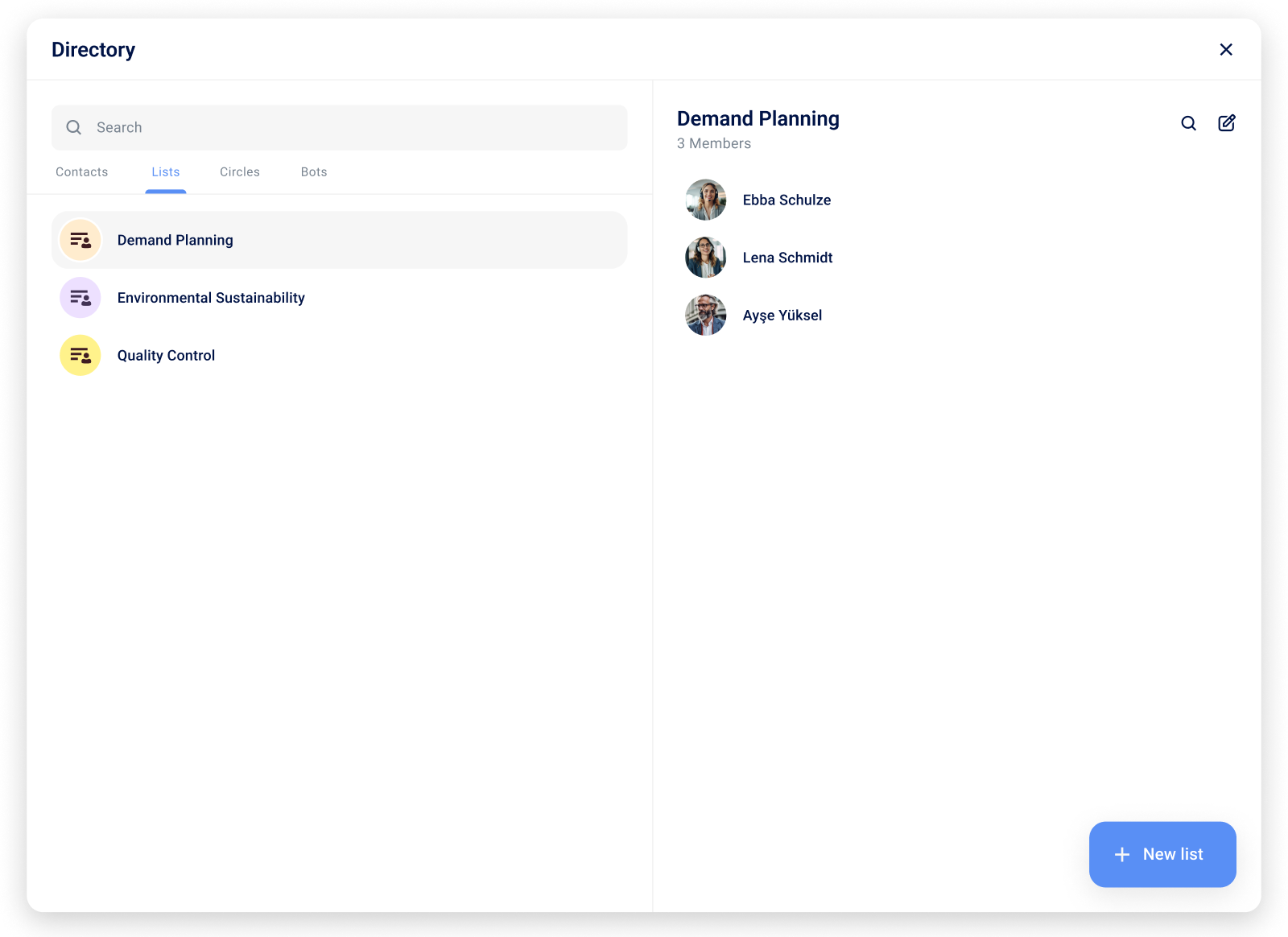c. Directory and Contacts
Atop your messages you can find the Directory. It shows all synchronised Contacts; created Lists; Circles to which you have been assigned to by your Teamwire admin; and Bots, that you have access to.
Search
Make use of the search bar located atop the list of contacts to look for your colleagues. Enter (parts of) their name to see all of yours and other organisation's matching users. If a user is from another organisation, their associated organisation name will be shown.
In the corresponding tabs of the directory, you can also search for names of lists, circles and bots.
Contacts
In the Contacts tab you can see all users, sorted by their first name. The list shows all users which your Teamwire administrator allows you to see.

Contact info
Click on a contact's name to open their profile and contact information.
Depending on the data each of them has added, you will find a profile picture and info about their Organisation,
Department,
Role, or even
phone number.
Start chat
Start a 1:1 conversation via the Chat button. You will be forwarded to the chat view automatically.
Start video call
Start a video call via the Video button. As voice and video calls can only be made within chats, you will be forwarded to a new or existing 1:1 chat. Begin your call with Start video call.
Start voice call
Start a voice call via the Call button. As voice and video calls can only be made within chats, you will be forwarded to a new or existing 1:1 chat. Begin your call with Start voice call.
Send email
If the user has added their email address to their contact data, you will find an Email button. The user's address will be moved to your default mail app where you can start composing an email.
Block a user
When you block a user, they will not be able to create a 1:1 chat with you, or write messages to any existing 1:1 chats. If you are participating in a group chat with a blocked user, their messages will not be displayed to you.
To block a user, open their profile and click Block user and confirm the prompt. Their profile will show a button to Unblock user, if you have already blocked them. Thus, you will be able to revoke a block.
Alternatively, you can find a list of all blocked users in the Account section at Privacy > Blocked contacts where you can unblock them.
Contacts from other organisations
If your Teamwire admin allows communicating with externals, you may find users from other organisations in your contacts.
Use the search bar and look for users. Their associated organisation name will be shown.
Requirements for finding users from other organisations
- Your Teamwire administrator has enabled a policy allowing the communication with external users
- The external's Teamwire administrator allows their users to be found in the directory
- The users are hosted on the same Teamwire Server (backend)
Federated contacts
If your Teamwire administrator has enabled Teamwire Federation, you may find users of other organisations from another Teamwire Server (backend) in your contacts.
They will automatically be shown in your list of contacts. They will show the Teamwire Federation icon and their associated backend name.
Requirements for synchronising external users from another Teamwire Server
- Your Teamwire administrator has configured Teamwire Federation with another Teamwire Server (backend)
- Your Teamwire administrator has enabled your user account to use Teamwire Federation
Lists
Lists are used to quickly and easily create a new chat with a predefined group of people in Teamwire, similar to a mailing list. Meaning, you can create multiple chats with the same list(s) based on different topics or projects.
Lists are contact groups that you created yourself and are available in your directory only. Their users will not be notified of being part of your list. Think of lists as a kind of "private circles".
When a chat is created, the list is parsed into its individual users which are added as independent chat participants. Unlike circles, they will be directly listed in the list of chat members.
Your lists are synchronised to all devices you have logged in with your Teamwire account.

Create a list
To create a new list, open the Lists tab and click
New List in the lower right corner.
- Define list name
Define a name for your list. It is best to choose a name you can easily associate to the group of people.
- Select members
Select members from your list of contacts. You may use the search bar to find contacts faster.
Confirm the creation of your list by clicking OK. You will return to your directory.
Manage lists
To edit an existing list, click on the name of the corresponding list in your directory to display all current members.If you want to add or remove contacts from your list later, click on the name of the list to view and edit it all current members.
- Rename list
Clickand select the option
Rename list.
- Add members
Clickand select the option
Add members. You may use the search bar to find contacts faster and then select the members from your list of contacts.
- Remove members
Move your cursor over the respective user, click on theicon to open the context menu and select
Remove from list.
Delete lists
To delete a list, click on the name of the corresponding list in your directory. Click , then select
Delete list and confirm the prompt message.
Please notice that this action cannot be undone.
Circles
Circles are used to quickly and easily create a new chat with a predefined group of people in Teamwire, similar to a mailing list. Meaning, you can create multiple chats with the same circle(s) based on different topics or projects.
Circles are managed by your Teamwire administrator and cannot be modified by you.
In your directory, you will find all circles you are a member of yourself. You can use them when creating a chat or add them to an existing group conversation at a later time.
Circles usually have names you can easily associate to a group of people, e.g. departments or teams.
Public circles
Public circles are managed by your Teamwire administrator and cannot be modified by you.
In your directory, you will find all public circles of your organisation without being a member yourself. You can use them when creating a chat. This allows special use cases, such as in the example below.
- Example: Confidential information
You can now contact the HR department via chat and submit a photo or scanned document of your sick note. Therefore, you create a chat with the public circle "Personnel office". Your get in contact with the "Personnel office" circle without inviting all other employees of the organisation.
Bots
Bots are external applications (e.g. chat bots) that you have been given access to by your Teamwire administrator. They are always labelled with the suffix Bot so that users know that they are not talking to a real person.
For example, the RSS Bot, the WhatsApp Bot, a Web Chat Widget Bot, even a Barcode Scanner or a Flic Button Bot are just a few examples of useful and popular bots. In this article you can find more information and further examples of bots.

